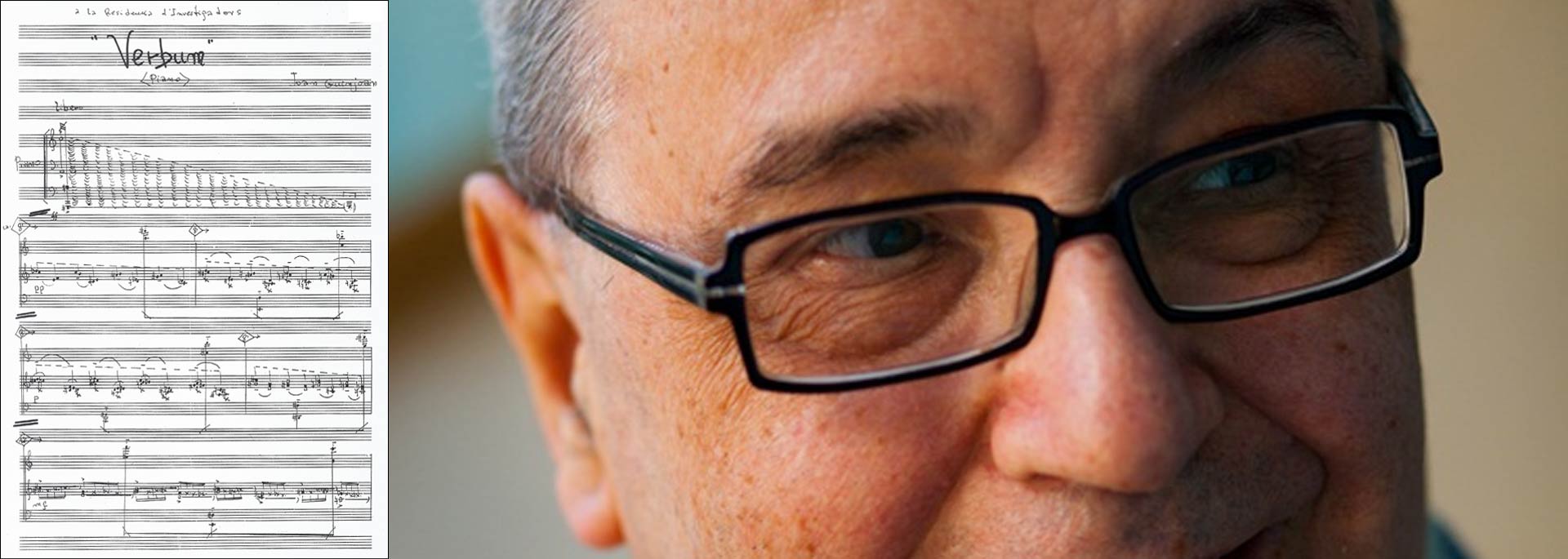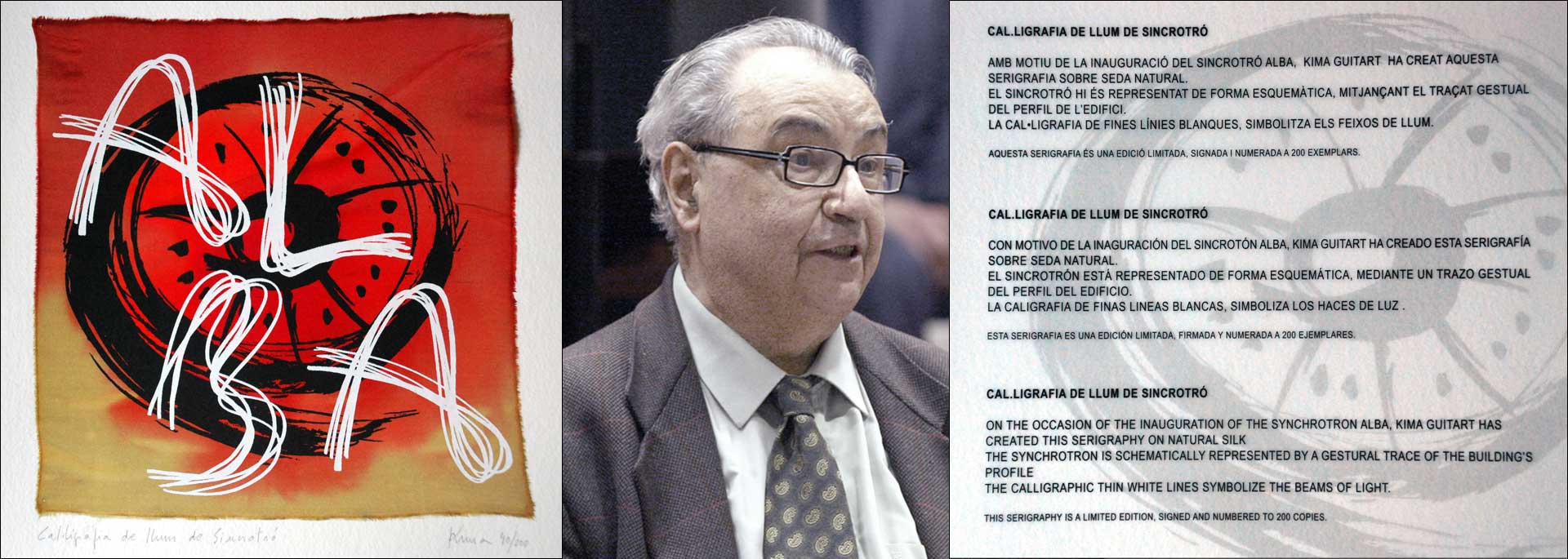
Commissioned by the Residence for Researchers to the composer Joan Guinjoan
Premiere: Barcelona, Auditorio de la SGAE, 10th October 2003. Josep Colom
The Residence for Researchers, taking the expression "science is culture" as its own motto, and in a permanent effort to encourage and promote both cultural and scientific creativity, has organised a range of activities such as the series of lectures "Gens Millenium", "Nanotechnology: 21st century paradigm", "Proteomics: Tools for Daily Life in the Postgenomic Era", "Contemporary Music, current prospects in Catalonia", and the exhibitions "People and Genes" and "Life Secrets: DNA cells”. The series of lectures was held to celebrate the 50th anniversary of the first description of the double helix. Now we want to go further, to link the world of science to that of culture at the very dawn of the new century: to bring together the most contemporary musical creation with one of the scientific discoveries that is going to revolutionise our existence: the deciphering of the human genome.
With this initiative, our intention is to humanise and to place music within the extended debate that this great scientific breakthrough has generated regarding the future of our human species. The project originated when Professor Joan Guinjoan was asked by the Residence for Researchers to compose a piece of music. Once he found out all about the human genome, the Professor – who has the gift of a spirit of constant searching and also possesses a mind that is open to any new scientific breakthroughs – experienced a great creative inspirational spark that resulted in this piece of music. Among the 30,000 genes that are thought to form part of the human genome, we were suggested and consequently given – by the Professors Roderic Guigó and Francesc Abril, bioinformaticians at Pompeu Fabra University and signatories of the first publication of the human genome (1) – the gene sequence that is associated with speech, FOXP2. Professor Guinjoan has used a poetic, musical transcription to represent the sequence within.
Leaving the musical performance aside, we should point out that this gene has also caught the attention of Professor Svante Pääbo (2). This scientist is Director in Chief of the Molecular Genetics Department at the Max Planck Evolutionist Anthropology Institute. Professor Pääbo says that, by using FOXP2, it is possible to determine the precise moment when humans made that qualitative jump which changed their behaviour completely; that is, when we achieved organised language which enables us to sing, and to produce sounds, music and poe

Commissioned by the Residence for Researchers to the composer Joan Guinjoan
Premiere: Barcelona, Auditorio de Barcelona, 7th May 2010. Performed by the Orquesta Sinfónica de Barcelona y Nacional de Cataluña, and conducted by Ernest Martínez Izquierdo
This symphony was a joint commission by the Consorci de la Residència d’Investigadors (CSIC-Generalitat de Catalunya) and the Consorci per a la Construcció, Equipament i Explotació del Laboratori de Llum Sincrotró (CELLS), to commemorate the inauguration, on 22nd March of that year, of the ALBA Synchrotron Light Laboratory.
The commission and the creation of the symphony to the ALBA Synchrotron by the Maestro Joan Guinjoan was designed to highlight the idea that the brotherhood between Science and Art represents a guarantee for a better future and progress for our country, at the same time stressing the important progress and commitments that Catalonia and the Spanish State have made over recent years to take their place in the elite of international scientific research.
The Synchrotron ALBA is a third-generation scientific facility situated in Cerdanyola del Vallés (Barcelona), and it is the most important such infrastructure in the Mediterranean area.
It is a complex of electron accelerators for producing synchrotron light, which enables us to visualise the atomic and molecular structure of matter and to study its properties.
The electron beam energy generated by ALBA is calculated at 3 GeV, and is achieved through a combination of a linear accelerator (LINAC) and a low-emittance, maximum power booster placed in the same tunnel as the storage ring. The Synchrotron ALBA has a parameter of 270 m and 17 straight sections available for the installation of insertion devices.
Currently, the ALBA has eight operative beamlines, which include soft x-rays and hard x-rays, and are mainly used for biosciences, condensed matter (nanoscience and magnetic and electronic properties) and material science. There are two more beamlines currently under construction low-energy, ultra-high-resolution angular photoemission for complex materials and microfocus for macromolecular crystallography.
And so what does a synchrotron sound like to Guinjoan? Firstly, it sounds like speed, the dizzying speed of the electrons, which he transposes into clusters of multiple isolated sounds, and glissandi which represent the injector that sets them in motion. The second movement – which sounds peaceful, almost dreamlike – evokes the experience of the researchers in the seven laboratories that are illuminated by synchrotron light. The third movement sounds like a party, with a resounding final section “in which the members of the orchestra will have little time to rest”.
The Maestro Joan Guinjoan offers a classical structure in three movements, a moderato agitato inspired by electrons that allows him to play around with the different instruments, and which is an overall acoustic process that evokes clusters of dreams, while at the same time treating the strings as if they were a quartet. The second movement, calmo, reflects what goes on in the seven or eight window-laboratories in the building, and which takes the form of a glissando which highlights various solo instruments. The third movement (vivo) is a fiesta, a Rondo with lots of Afro-Cuban rhythmic elements in which the electrons make their reappearance, and which finishes brightly with tubas, trombones and trumpets.
All of which goes to show that science and knowledge can also act as motors for inspiring art, and which also demonstrates that the sublime dimension of this art is often the legacy of the scientific creator.

Commissioned by the Residence for Researchers to the composer Joan Guinjoan
Premiere: Palau de la Música, Barcelona, 21st October 2016. Orquesta del Gran Teatro del Liceo, conducted by the Maestro Josep Pons.
The UN declared 2015 to be the International Year of Light, and in this context the Residence for Researchers–CSIC Generalitat de Catalunya, in its desire to link music with science, decided that a musical symphony inspired by light should be premiered for the general public to celebrate the International Year of Light.
Professor María Josefa Yzuel, President of the Committee, Emeritus Professor at the Autonomous University of Barcelona, Member of RACAB (Royal Academy of Arts and Science of Barcelona), 2009 President of SPIE (The International Society for Optics and Photonics) presented and explained the scientific aspects of light to the Maestro Joan Guinjoan on several occasions. To that end, we attach the literal notes that the Maestro Joan Guinjoan made and used for his subsequent musical interpretation.
These lessons represented a historical review of the links between light and science, starting with Homer and the popular beliefs expressed in the Iliad and the Odyssey, and continuing with other thinkers from antiquity, including Democritus, Plato, Aristotle, Euclid and Ptolemy. The lessons moved onto the thinkers of the Middle Ages, Alazen and Al-Farisi, leading up to modern mathematical optics in 1637, when Descartes published Discourse on the Method, a work that contained essays featuring the refraction of light for the first time, a phenomenon that Snell had established experimentally some years earlier. These two conceptions (Granular, from Plato and Democritus, and Dynamic, from Aristotle) have survived to the present day with successive modifications – Newton and Einstein’s corpuscular theories and Huygens, Fresnel and Maxwell’s wave theories. Given that the Frenchman Louis de Broglie established that light has a dual nature, some phenomena can be interpreted by their duality, on one hand (particles = corpuscles = photon, photoelectric effect), and on the other hand by wave theory (reflection, diffraction and refraction). It also proves that each wave has a photon associated with it. Einstein (Nobel Prizewinner, 1920) experimentally demonstrated the photoelectric effect. When light strikes a metal plate, each photon associated with light throws out an electron, producing an electrical current.
From the rising to the setting of the sun, the Maestro Joan Guinjoan took inspiration from a poem by the poet Antonio Clapès, which he used as a script for the phenomena that occur while sunlight shines
1.- Waveform
When light passes through a small aperture, it turns into light waves that spread in many directions; the light that we see behind the tree, the sun also strikes on its front; for example, the olive and the hazel tree.
The aurora borealis is made up of tiny particles (dust), which turn light into luminous waves that spread in many directions. The colour depends on the nature of the particles.
Sunset. Clouds and the particles in the Earth’s atmosphere turn light into luminous waves that spread in many directions.
This describes the change in direction that light experiences when it travels from one medium at a certain speed to another at a lower speed. This reduction in speed is linked with the density of the medium; for example, when light travels from air into water.
Newton’s quartz prism, which breaks light down into seven colours: red, orange, yellow, green, blue, violet and indigo. In symmetry with the seven musical notes and with wave tones and lengths, which range from low to sharp tones.
Rainbows. Tiny drops of water in suspension which remain in the atmosphere after a storm, and which break light down into the aforementioned seven colours.
2.- Corpuscular
Corpuscular = Photons
As shown in the handwritten notes made by the Maestro Joan Guinjoan, which are mentioned above and the musical interpretation of which are reflected in the sheet music pages that we have attached